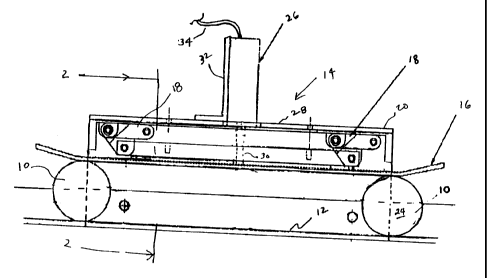Some of the information on this Web page has been provided by external sources. The Government of Canada is not responsible for the accuracy, reliability or currency of the information supplied by external sources. Users wishing to rely upon this information should consult directly with the source of the information. Content provided by external sources is not subject to official languages, privacy and accessibility requirements.
Any discrepancies in the text and image of the Claims and Abstract are due to differing posting times. Text of the Claims and Abstract are posted:
| (12) Patent: | (11) CA 2329222 |
|---|---|
| (54) English Title: | ESCALATOR ROLLER DEGRADATION MONITOR DEVICE |
| (54) French Title: | DISPOSITIF DE SURVEILLANCE DE LA DETERIORATION DE ROULEAUX D'ESCALATEUR |
| Status: | Expired |
| (51) International Patent Classification (IPC): |
|
|---|---|
| (72) Inventors : |
|
| (73) Owners : |
|
| (71) Applicants : |
|
| (74) Agent: | RICHES, MCKENZIE & HERBERT LLP |
| (74) Associate agent: | |
| (45) Issued: | 2007-02-13 |
| (22) Filed Date: | 2000-12-20 |
| (41) Open to Public Inspection: | 2001-06-21 |
| Examination requested: | 2003-11-13 |
| Availability of licence: | N/A |
| (25) Language of filing: | English |
| Patent Cooperation Treaty (PCT): | No |
|---|
| (30) Application Priority Data: | ||||||
|---|---|---|---|---|---|---|
|
A roller degradation monitor device monitors the diameter of escalator rollers during operation of the escalator. A cam plate is mounted proximate the roller track for sequential contact with the upper circumference of rollers as they travel along the track. The vertical displacement of the cam plate is monitored by a proximity switch or sensor, differences in cam plate practice from an established baseline signifying variations in roller diameter. The output of the proximity switch or sensor provides a continuous measure of wear and decrease in diameter of the rollers. When the wear exceeds a predetermined value an alarm can be actuated.
Dispositif de surveillance de la dégradation des rouleaux d'escalateur qui surveille le diamètre des rouleaux d'escalateur pendant que ce dernier fonctionne. Un disque à cames est installé près du rail des rouleaux aux fins de contact séquentiel avec la circonférence supérieure des rouleaux alors qu'ils se déplacent le long du rail. Le déplacement vertical des disques à cames est surveillé par un détecteur ou un capteur de proximité, les différences de pratique des disques à cames à partir des conditions de base établies signifiant des variations de diamètre des rouleaux. La sortie du détecteur ou du capteur de proximité fournit une mesure continue de l'usure et de la réduction du diamètre des rouleaux. Lorsque l'usure dépasse une valeur prédéterminée, une alarme peut être actionnée.
Note: Claims are shown in the official language in which they were submitted.
Note: Descriptions are shown in the official language in which they were submitted.

For a clearer understanding of the status of the application/patent presented on this page, the site Disclaimer , as well as the definitions for Patent , Administrative Status , Maintenance Fee and Payment History should be consulted.
| Title | Date |
|---|---|
| Forecasted Issue Date | 2007-02-13 |
| (22) Filed | 2000-12-20 |
| (41) Open to Public Inspection | 2001-06-21 |
| Examination Requested | 2003-11-13 |
| (45) Issued | 2007-02-13 |
| Expired | 2020-12-21 |
There is no abandonment history.
| Fee Type | Anniversary Year | Due Date | Amount Paid | Paid Date |
|---|---|---|---|---|
| Registration of a document - section 124 | $100.00 | 2000-12-20 | ||
| Application Fee | $300.00 | 2000-12-20 | ||
| Maintenance Fee - Application - New Act | 2 | 2002-12-20 | $100.00 | 2002-11-25 |
| Request for Examination | $400.00 | 2003-11-13 | ||
| Maintenance Fee - Application - New Act | 3 | 2003-12-22 | $100.00 | 2003-12-02 |
| Maintenance Fee - Application - New Act | 4 | 2004-12-20 | $100.00 | 2004-11-25 |
| Maintenance Fee - Application - New Act | 5 | 2005-12-20 | $200.00 | 2005-11-28 |
| Final Fee | $300.00 | 2006-11-02 | ||
| Maintenance Fee - Application - New Act | 6 | 2006-12-20 | $200.00 | 2006-11-29 |
| Maintenance Fee - Patent - New Act | 7 | 2007-12-20 | $200.00 | 2007-11-23 |
| Maintenance Fee - Patent - New Act | 8 | 2008-12-22 | $200.00 | 2008-11-20 |
| Maintenance Fee - Patent - New Act | 9 | 2009-12-21 | $200.00 | 2009-12-04 |
| Maintenance Fee - Patent - New Act | 10 | 2010-12-20 | $250.00 | 2010-12-09 |
| Maintenance Fee - Patent - New Act | 11 | 2011-12-20 | $250.00 | 2011-12-08 |
| Maintenance Fee - Patent - New Act | 12 | 2012-12-20 | $250.00 | 2012-12-03 |
| Maintenance Fee - Patent - New Act | 13 | 2013-12-20 | $250.00 | 2013-12-09 |
| Maintenance Fee - Patent - New Act | 14 | 2014-12-22 | $250.00 | 2014-12-08 |
| Maintenance Fee - Patent - New Act | 15 | 2015-12-21 | $450.00 | 2015-12-07 |
| Maintenance Fee - Patent - New Act | 16 | 2016-12-20 | $450.00 | 2016-12-13 |
| Maintenance Fee - Patent - New Act | 17 | 2017-12-20 | $450.00 | 2017-12-11 |
| Maintenance Fee - Patent - New Act | 18 | 2018-12-20 | $450.00 | 2018-12-10 |
Note: Records showing the ownership history in alphabetical order.
| Current Owners on Record |
|---|
| INVENTIO AG |
| Past Owners on Record |
|---|
| BONITZ, WILLIAM |
| FRAZIER, ROGER L. |
| KAO, MICHAEL D. |
| NORTH, ROBERT T. |
| SMITH, MELANIE JEAN |
| VON OFFERMAN, KIRK |